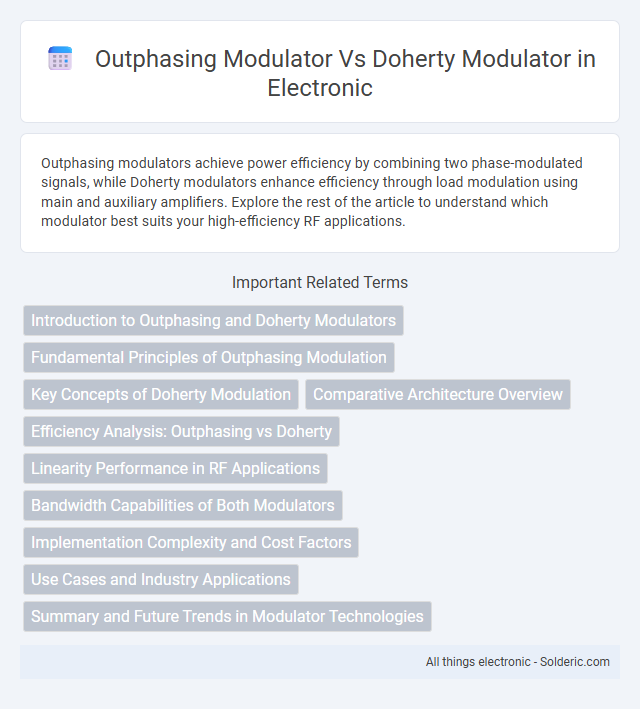Outphasing modulators achieve power efficiency by combining two phase-modulated signals, while Doherty modulators enhance efficiency through load modulation using main and auxiliary amplifiers. Explore the rest of the article to understand which modulator best suits your high-efficiency RF applications.
Comparison Table
| Feature | Outphasing Modulator | Doherty Modulator |
|---|---|---|
| Modulation Technique | Combines two constant-envelope signals with controlled phase difference | Uses carrier and peaking amplifiers operating in parallel for efficiency |
| Efficiency | High efficiency at backed-off power due to envelope separation | Improved efficiency especially at 50% power back-off |
| Linearity | Maintains linearity via phase control, suitable for complex modulations | Linearity depends on load modulation, requires linearization techniques |
| Complexity | High complexity due to phase modulation and combining network | Moderate complexity with simpler load modulation design |
| Applications | Used in RF transmitters needing high linearity and efficiency | Common in base stations and power amplifiers for cellular networks |
| Power Handling | Effective at moderate to high output power levels | Designed for efficient power amplification in medium to high power |
Introduction to Outphasing and Doherty Modulators
Outphasing modulators achieve linear amplification by combining two constant-envelope signals with varying phase differences, optimizing power efficiency in RF transmitters. Doherty modulators utilize a main and auxiliary amplifier that share the load dynamically, enhancing efficiency especially at back-off power levels in wireless communication systems. Both architectures are critical for modern power amplifier designs targeting improved linearity and energy efficiency in mobile and broadcasting environments.
Fundamental Principles of Outphasing Modulation
Outphasing modulation operates by combining two constant-envelope signals with varying phase relationships to achieve amplitude modulation, enhancing efficiency in RF power amplifiers. It converts amplitude variations into phase differences, enabling linear amplification with reduced distortion and power consumption. Your choice of an outphasing modulator influences transmitter performance, especially in applications demanding high linearity and energy efficiency compared to Doherty modulators.
Key Concepts of Doherty Modulation
Doherty modulation employs a main amplifier and a peaking amplifier to enhance power efficiency by dynamically adjusting power delivery based on signal amplitude, making it especially effective for high peak-to-average power ratio (PAPR) signals. The key concepts include load modulation, where the impedance seen by the amplifiers varies with input power, and combining the outputs to maintain linearity while improving efficiency at back-off power levels. This approach contrasts with Outphasing modulation, which combines phase-modulated carrier signals to optimize efficiency through controlled phase relationship.
Comparative Architecture Overview
Outphasing modulators split the input signal into two constant-envelope components, modulating their phase independently before recombining them to achieve amplitude modulation, thereby enhancing linearity and efficiency in RF power amplification. Doherty modulators utilize a main and auxiliary amplifier operating in parallel with load modulation to dynamically improve efficiency at back-off power levels, particularly effective in handling signals with high peak-to-average power ratios. While Outphasing architecture offers simplified envelope tracking through phase control, Doherty architecture excels in efficiency enhancement by exploiting amplifier load modulation and combining techniques.
Efficiency Analysis: Outphasing vs Doherty
Outphasing modulators achieve high efficiency by combining two constant-envelope signals with varying phase, minimizing power loss in power amplifiers during back-off operation. Doherty modulators enhance efficiency through load modulation, dynamically adjusting the impedance presented to the main amplifier to optimize performance at different output power levels. Your choice depends on the specific application requirements, with Doherty modulators typically offering better back-off efficiency for modern communication systems.
Linearity Performance in RF Applications
Outphasing modulators achieve linearity in RF applications by combining two constant-envelope signals with varying phase, minimizing distortion through precise phase control. Doherty modulators enhance linearity by dynamically redistributing current between the main and peaking amplifiers based on output power, effectively improving efficiency while maintaining signal integrity. Linearity in Doherty modulators tends to degrade at back-off power levels compared to outphasing architectures, which can maintain better linearity across a wider range of output powers.
Bandwidth Capabilities of Both Modulators
Outphasing modulators typically offer wider bandwidth capabilities due to their ability to handle a broader spectrum by combining two phase-modulated signals, making them suitable for high-frequency and wideband applications. Doherty modulators, while highly efficient for power amplification in narrowband or moderately wideband systems, tend to have more limited bandwidth performance because of the inherent design constraints in maintaining load modulation and efficiency. The bandwidth advantage of outphasing modulators makes them preferable for modern communication systems requiring flexibility across multiple frequency bands.
Implementation Complexity and Cost Factors
Outphasing modulators typically involve higher implementation complexity due to the need for accurate phase control and linearization techniques, which can drive up design and manufacturing costs. Doherty modulators offer a comparatively simpler architecture with efficiency enhancements for power amplifiers, resulting in lower overall system cost but requiring careful tuning of carrier and peaking amplifiers. Your choice between the two may depend on balancing the sophistication of phase management against cost constraints and performance requirements.
Use Cases and Industry Applications
Outphasing modulators excel in wireless communication systems requiring high linearity and efficiency, such as 5G and satellite transmissions, where signal distortion must be minimized. Doherty modulators are widely used in cellular base stations and broadcast transmitters to enhance power amplifier efficiency under varying load conditions. Your choice depends on whether your application prioritizes signal linearity and wide bandwidth (Outphasing) or improved power efficiency with dynamic signal levels (Doherty).
Summary and Future Trends in Modulator Technologies
Outphasing modulators offer improved linearity and efficiency by combining two constant envelope signals but face challenges with complexity and bandwidth limitations. Doherty modulators enhance power efficiency through load modulation and have become increasingly favored in 5G base stations due to their superior back-off efficiency and scalability. Your choice of modulator technology will depend on future trends emphasizing higher frequency operations, integration with digital predistortion, and energy-efficient designs for next-generation wireless communication systems.
Outphasing modulator vs Doherty modulator Infographic

 solderic.com
solderic.com